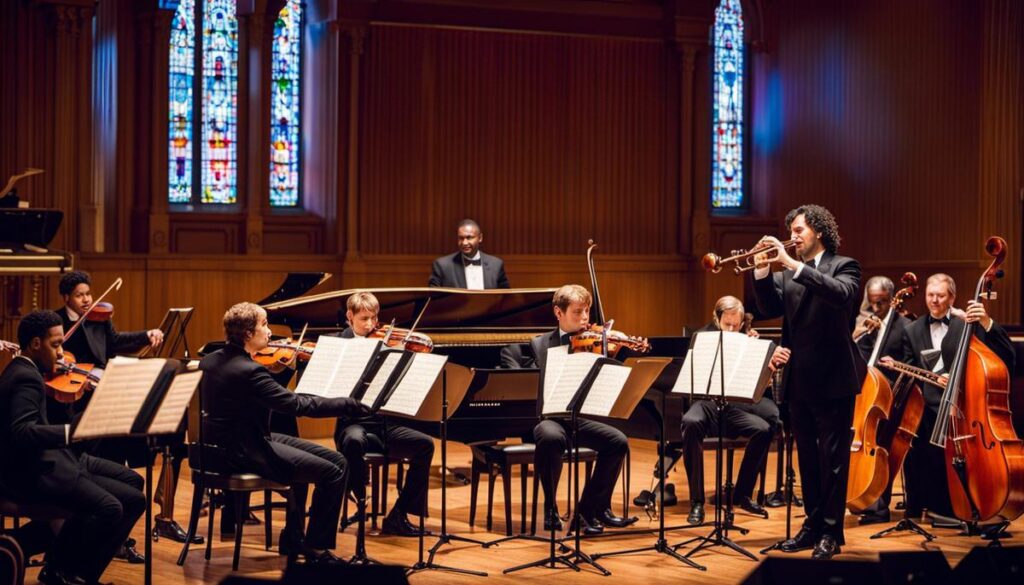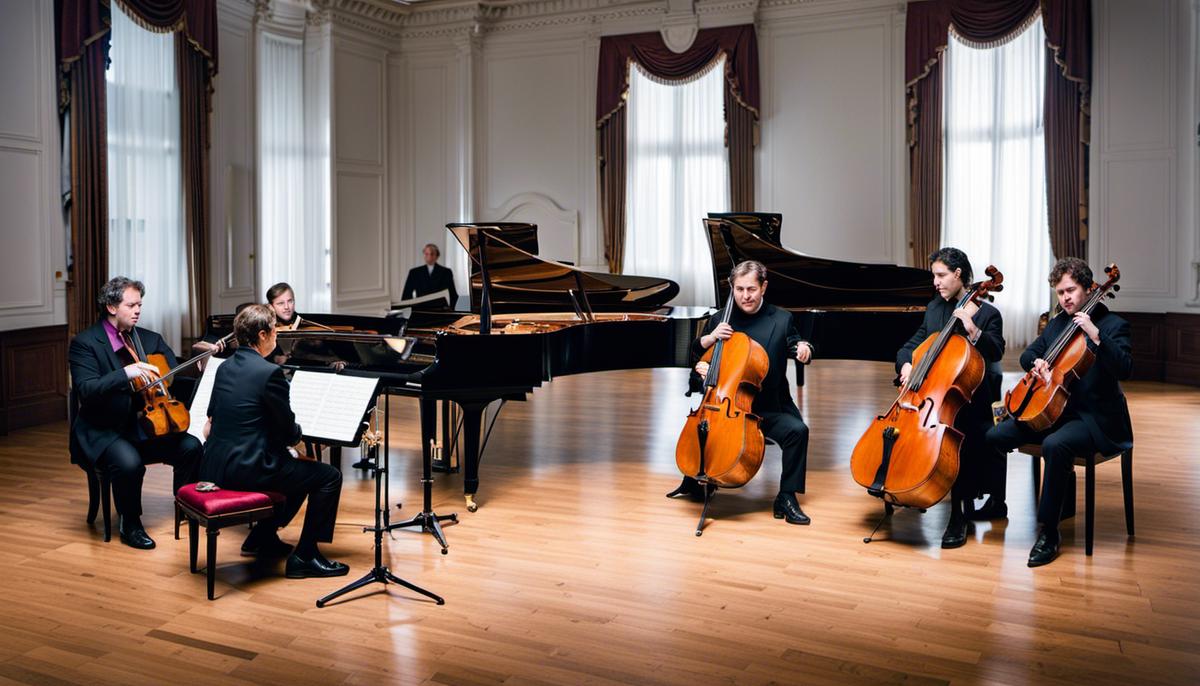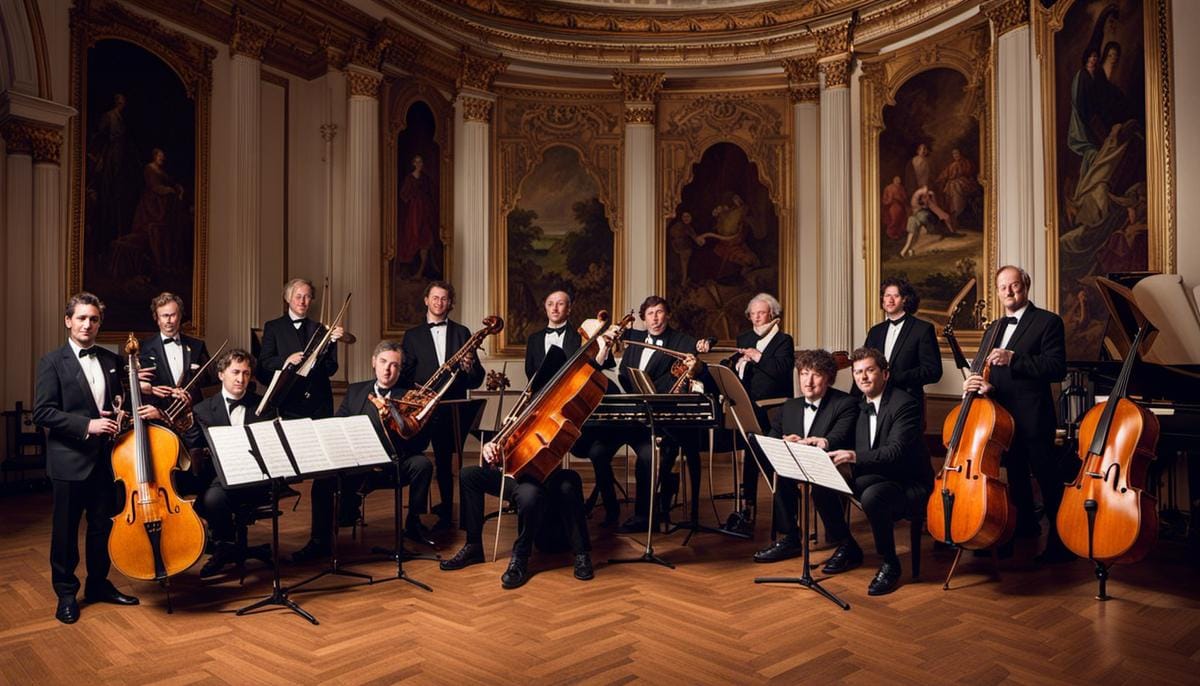Table of Contents
Introduction
The vast and vibrant world of chamber ensemble music is replete with unexplored avenues and hidden treasures. Oftentimes in music appreciation, the spotlight is reserved for the mainstream and the popular, arguably overlooking the subtle nuances and unique genius found in less popular works. This discourse intends to diverge from this common narrative and focus on the underappreciated and hidden jewels of chamber ensemble music.
In this article, we analyze the unique compositions of lesser-known composers to understand, and appreciate these musical hidden gems.
Overview of Chamber Ensemble Music
The Genesis and Evolution of Chamber Ensemble Music
Chamber music, which later evolved into chamber ensemble music, traces its origins back to the Classical era. It began as a form of entertainment in an intimate setting – often the chamber or living rooms of the aristocracy. This is where the genre derives its name. Chamber ensemble music gradually developed a precise format: a string quartet, including two violins, a viola, and a cello. The quartet usually performed scores written specifically for this instrumental configuration. Famous composers like Wolfgang Amadeus Mozart, Joseph Haydn, and Ludwig van Beethoven were instrumental in the evolution and global recognition of chamber ensemble music.
Importance and Unique Characteristics of Chamber Ensemble Music
One significant feature of chamber ensemble music is the individual part each instrument plays. There is no single instrument dominating the composition; rather, the music achieves its full texture and richness through the harmonious integration of the multiple instruments. This balance grants chamber ensemble music its unique sound. It remains an important genre in that it highlights the musicians’ communication skills, demonstrating how they listen to, respond, and interpret each other’s musical cues. The intimacy of the setting also allows for a more immediate and personal connection with the audience.
Paradigms and Trends Across Historical Periods
Chamber ensemble music proved its malleability by adapting to different trends across various eras. In the Romantic era, the music embraced more emotional depth and complexity, reflecting composers’ heightened focus on emotional expressivity. Later, during the 20th and 21st centuries, the music saw an expansion in the types and number of instruments employed. There was a particular emphasis on exploring innovative sounds.
Exploring Lesser-known Chamber Ensemble Pieces
Reaching beyond the widely known pieces from renowned composers like Franz Schubert or Johannes Brahms can yield rewarding discoveries. Lesser-known works often feature unique character and craftsmanship that distinguish them from the more mainstream repertoire. For instance, consider Russian composer Sergei Taneyev’s chamber works that exemplify his technical precision and rich harmonies, or explore British composer Ethel Smyth’s music, whose works were largely overshadowed due to the gender prejudices of her time.
Unearthing the Hidden Gems of Chamber Ensemble Pieces
As enthusiasts, tapping into the lesser-known chamber ensemble pieces can offer an incredibly enriching perspective on the genre’s capabilities and variations. By seeking out and shedding light on these largely unexplored pieces, we get to experience the ingenuity and creativity often missed in their obscurity. This discovery isn’t merely about supplementing our musical knowledge, but it also presents an opportunity to broaden our musical articulate and comprehension of this beautiful form of music.

5 Under-Appreciated Chamber Ensemble Composers & Their Works
1. A Deep Dive into the Subtle Brilliance of John Field
Born in Ireland, John Field (1782-1837) is praised for pioneering the form of Nocturnes, which is usually associated with Chopin. The music that Field offers is characteristic of a profound sensitivity, complete with intricate nuances and a masterful employment of the piano. His contributions to chamber music, especially the Piano Quintet in E flat major and the Piano Trio in E flat major, are commendable and immensely appreciated. Field’s understated grandeur and his proficiency to create seamless musical textures in his works highlight him as a significantly undervalued virtuoso of chamber ensemble music.
2. Unveiling the Captivating Charm of Mieczysław Weinberg
Belarus-born Polish composer, Mieczysław Weinberg (1919-1996), is another significant figure in the landscape of ensemble music. Despite a life marked by war and hardship, he produced compelling music that pushed the conceptual boundaries of chamber ensemble music. His works – notably his 24 Preludes for cello solo and the Piano Trio, op. 24 – showed his mastery over counterpoint and sonority. His compositions remain steeply under-appreciated for their emotive depth and structural completeness.
3. The Forgotten Charm of Louise Farrenc
The only woman to hold a permanent position at the Paris Conservatory during the 19th century, Louise Farrenc (1804-1875) was a renowned pedagogue and composer. Her nonet for wind and strings shows her ability to balance conversational exchange between the instruments, and her three piano quintets deserve to be just as well known as those by Brahms or Dvorak. Her work is characterized by a sense of profoundness that rests comfortably within the established structure, invoking both emotional and intellectual responses.
4. The Sterling Sonic Surprises presented by William Alwyn
British composer William Alwyn (1905-1985) left a significant mark on the landscape of chamber music. Alwyn’s lesser-known works such as his three string quartets and the wind quintet masterfully exploit the sonic possibilities of their respective genres. Much like his extensively researched books on music and painting, Alwyn’s compositions are studies of depth and detail where every note carries a precise intention.
5. Julius Röntgen’s Symphonic Spectacles
Julius Röntgen (1855-1932), a Dutch composer of German origin, was a prominent figure in Europe’s musical life around the turn of the 20th century. His chamber music includes 16 string trios, a plethora of piano trios, a number of piano quintets, sextets, septets, and octets as well as more unusual combinations. His compositions, particularly his sextet in G major and the piano quintet in A minor, are characterized by elegantly flowing melodies and harmonies that speak directly to the heart, yet remain largely underperformed and under-appreciated.
Unearthing the works of composers who have left a vibrant legacy in the realm of chamber music often opens doors to a newfound appreciation. The abundant richness and varied divergence embedded within lesser-known chamber ensemble pieces reflect the immeasurable contributions of these composers.

Analyzing the Musicality of Lesser-Known Pieces
Demystifying the Charm of Chamber Ensemble Music
Chamber ensemble music, a fascinating facet of classical music, caters to an intimate audience with small ensembles, usually ranging from two to nine musicians playing individual parts. The beauty of this genre lies in the subtle communication among the performers, amplifying the collaborative elements of the performance, and providing it with a unique charm. The intricate intermingling of individual parts crafted to achieve a collective harmony distinguishes chamber ensemble music, making it a rewarding field of study for music enthusiasts and aspiring musicians alike.
Analyzing Harmony in Lesser-Known Chamber Pieces
Harmony can be described as the vertical aspect of music, and it is understood as the sounding together of two or more notes. In analyzing the harmony of lesser-known chamber ensemble pieces, it’s crucial to listen for how the different parts work together to create a whole. This involves observing how dissonances are resolved, how chords are connected, and how the harmonic progressions contribute to the structure and emotional content of the music piece. Some pieces might incorporate unconventional or complex harmonic structures, further emphasizing the unique nature of the genre.
Dissecting Melody in Lesser-Known Chamber Pieces
Melody pertains to the arrangement of pitches in a sequential manner to form a recognizable musical entity in the horizontal aspect of music. In lesser-known chamber pieces, the melody may be advanced in a more intricate manner compared to typically heard mainstream pieces, with individual instrumental parts trading off the melodic line and creating a more layered texture. This often includes non-traditional melodic constructions and development. The challenge lies in following these melodies and understanding their nuances.
Examining Structure in Lesser-Known Chamber Pieces
The structure of a musical piece pertains to its overall form and organization. Most chamber music compositions adapt traditional musical forms like the sonata or the theme and variations. However, some lesser-known chamber pieces showcase more experimental structures, which might include asymmetric phrase structures or the cyclical repetition of a particular motif. Noteworthy is how these forms contribute to overall impact, inducing tension and release, and encouraging aural anticipation.
Gleaning Insight from Instrumentation in Lesser-Known Chamber Pieces
In terms of instrumentation, lesser-known chamber ensemble pieces might use a variety of instruments not typically combined in mainstream chamber music, expanding beyond the common trios, quartets, and quintets. These unusual combinations can bring out distinct musical textures and timbres that add to the pieces’ uniqueness and charm. Therefore, a detailed analysis of these pieces should involve observing how different instruments are utilized, how their individual timbres contribute to the ensemble’s overall sound, and how such interplay between instruments shapes the music.
Unleashing the Beauty of Lesser-Known Chamber Ensemble Pieces
Lesser-known chamber ensemble pieces, despite not being on the mainstream radar, are treasure troves of unique musical expressions and inventive approaches. These intriguing musical rarities offer an opportunity for thorough exploration into the diverse facets of music that stretches beyond the standard boundaries. Often undervalued, these pieces necessitate a heightened level of sensitivity and discernment to truly appreciate the depth of creativity, intelligence and emotion hidden within. It is critical to welcome these pieces with an open mind and a keen ear, fully embracing the unparalleled charm and complexity they present. Analyzing these works, far from the mainstream musical narrative, opens up a whole new vista that offers a richer, deeper understanding of the vast canvas of music.

Performance Guide for Obscure Chamber Ensemble Pieces
Becoming an Expert in Obscure Chamber Ensemble Pieces
Mastering the art of lesser-known chamber ensemble pieces requires a determined, specialized strategy. A number of these works are often overlooked owing to their intricate composition, unfamiliarity, or because they haven’t found popularity in mainstream music. Gaining an intricate understanding of the historical backdrop, style of composition and singular characteristics of these pieces is an absolute necessity when attempting to unravel their complexity. Just like any piece of music, these works, too, deserve the same level of understanding and appreciation.
Research and Historical Understanding
Delving into the piece’s history, such as its composer, period, and influences, gives you insight into the intended interpretation of the work. For example, understanding differences between Baroque, Classical, Romantic, or Modernist compositions greatly influences the performance style.
Learn about the composer and their stylistic idiosyncrasies. Knowing whether a composer favored techniques like rubato or certain harmonies can guide your own interpretation. Lesser-known pieces often have lesser-known composers, so independent research may be required.
Practice Strategies
Learning obscure chamber ensemble pieces often involves complex compositions, and may not have the benefit of numerous professional recordings for reference. To start, break the music into manageable sections, identify challenging passages for individual and group practice.
Instead of merely focusing on perfecting your individual part, strive to understand all the parts in the context of the entire ensemble. Listening closely to each other’s parts during rehearsals can deepen your understanding of the piece and help strengthen the unity and balance of the ensemble’s sound.
Interpretation and Expressiveness
Given the relative obscurity of the piece and possibly fewer interpretive traditions, there is often more room for adding your unique interpretation. Creating an individual interpretation requires a deep understanding of the musical language used in the composition and a strong expressive intention. Pay attention to every dynamic, articulation, and stylistic indication provided in the score. Remember, obscure does not mean insignificant or unimpressive; bring out the piece’s unique qualities with your performance.
Ensemble Cooperation
Ensemble cooperation is pivotal for successfully performing chamber music. Develop a performance plan with all members where everyone’s contributions are valued. Everybody should have a say in aspects such as volume, velocity, and vibrato, to achieve a unified interpretation. Agree on cues for tempo changes or entries, as chamber music often lacks a conductor.
Mastering lesser-known chamber ensemble pieces demands a diversified approach incorporating meticulous research, individual and collaborative rehearsals, informed interpretation, and harmonious performance.

Promoting Lesser-Known Chamber Ensemble Pieces
Diving Deeper into Lesser-Known Chamber Ensemble Pieces
Often presented by a small group of performers, chamber music consists of compositions for ensembles such as trios, quartets, quintets, and more. Despite the incredible variety and depth of these pieces, they frequently remain in the shadows, underperformed or overlooked. Obscure chamber ensemble compositions might include works from less renowned composers, pieces beyond the popular repertoire, or music from lesser-known eras and regions. Interestingly, even globally celebrated composers often have obscure chamber pieces in their catalogue that deserve the spotlight and more frequent performances.
The Importance of Promotion and Exposure
The promotion and increased exposure of these lesser-known chamber pieces can have significant impacts. Unveiling neglected masterpieces not only broadens the available repertoire but also allows musicians and audiences to explore different styles, techniques, and musical storytelling methods. These pieces can introduce fresh perspectives, stoke creativity, and inspire innovative interpretations that reinvigorate the art form. They can also provide a gateway into different cultures and histories, fostering an inclusive and comprehensive understanding of classical music’s global landscape.
Role of Music Enthusiasts and Educators
Music enthusiasts, educators, performers, and concert organizers hold the key to promoting lesser-known chamber pieces. Music enthusiasts can significantly influence trends through discussions, social media sharing, blogs, podcasts, and even word-of-mouth recommendations. Educators can include these pieces in their curricula, encouraging students to explore and appreciate these works while developing their performance skills and understanding of musical styles. They can also host masterclasses, workshops, and seminars dedicated to the study and performance of lesser-known pieces.
Investing in Performers and Concert Organizers
Performers bring music to life, and choosing to perform a lesser-known chamber piece can give it much-needed visibility. Concert organizers, in turn, can ensure these pieces are included in their programming, providing both performers and audiences alike access to this vast but relatively unexplored facet of classical music. Apart from traditional concert settings, these pieces could also be performed at community events, educational institutions, and local venues, directly introducing them to diverse and potentially new audiences.
Promoting through Recordings
Recordings are a powerful tool for promoting lesser-known chamber ensemble pieces. Musicians and recording companies can invest in recording these pieces, providing a more permanent and widely accessible form of these works. Besides traditional audio recordings, video performance recordings (including live streaming) also play a significant role in the modern digital age, potentially reaching a global audience.
The Power of Research and Scholarship
Scholars can contribute immensely to bringing exposure to lesser-known chamber ensemble pieces by language translation, exploration, and contextual documentation. Detailed research can shed light on the historical, cultural, and structural aspects of these works. This understanding can then enhance the performance and appreciation of these pieces. Research articles, dissertations, and scholarly publications could actively contribute towards raising awareness and interest, and eventually empowering these pieces with the prominence they deserve.

Conclusion
Navigating through the labyrinth of chamber ensemble music, it becomes evident that the spotlight of popularity does not always illuminate the greatest works. Countless underappreciated pieces of chamber ensemble music, despite their lack of widespread fame, resonate with sheer intrinsic musicality and exceptional compositional brilliance.
By engaging with these lesser-known works as performers, music enthusiasts, educators, and concert organizers, we can enrich our understanding of music as well as broaden the collective musical palette. Let us strive towards not only appreciating these hidden gems but also amplifying their reach, thereby diversifying musical narratives and fostering a deeper appreciation of the boundless depth and breadth of chamber ensemble music.
Additional Reading
Take some time to check out our other articles:
Breve Music Studios publishes music to Spotify, YouTube Music, Amazon Music and more. Follow our pages on Facebook, Instagram, Twitter, TikTok, and YouTube.
Listen to our ensembles: Breve Orchestra, Breve Music Ensemble, Breve Low Brass Ensemble, Breve Woodwind Ensemble, and Jermaine Harris on Spotify.

